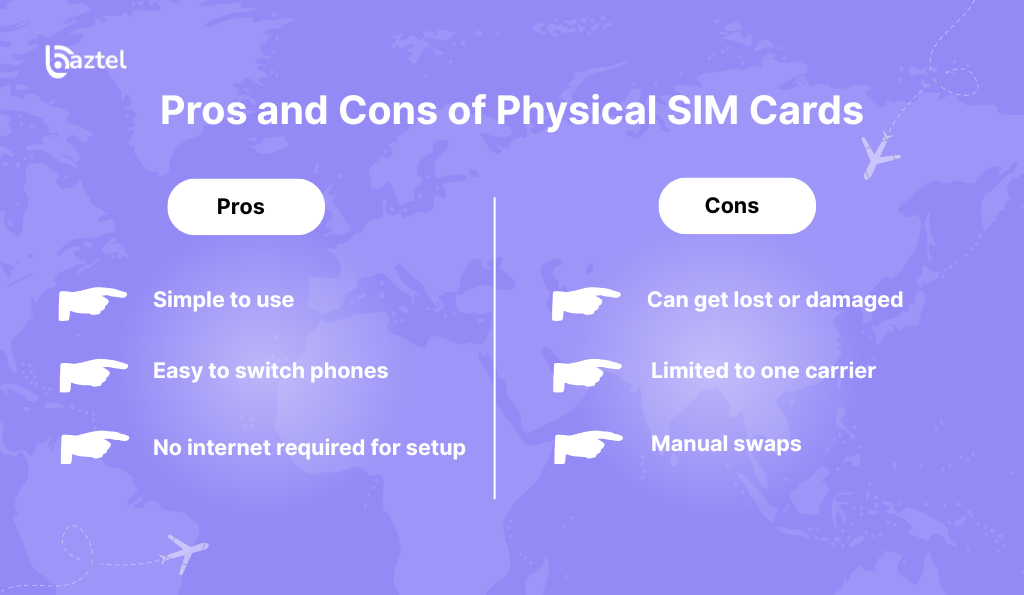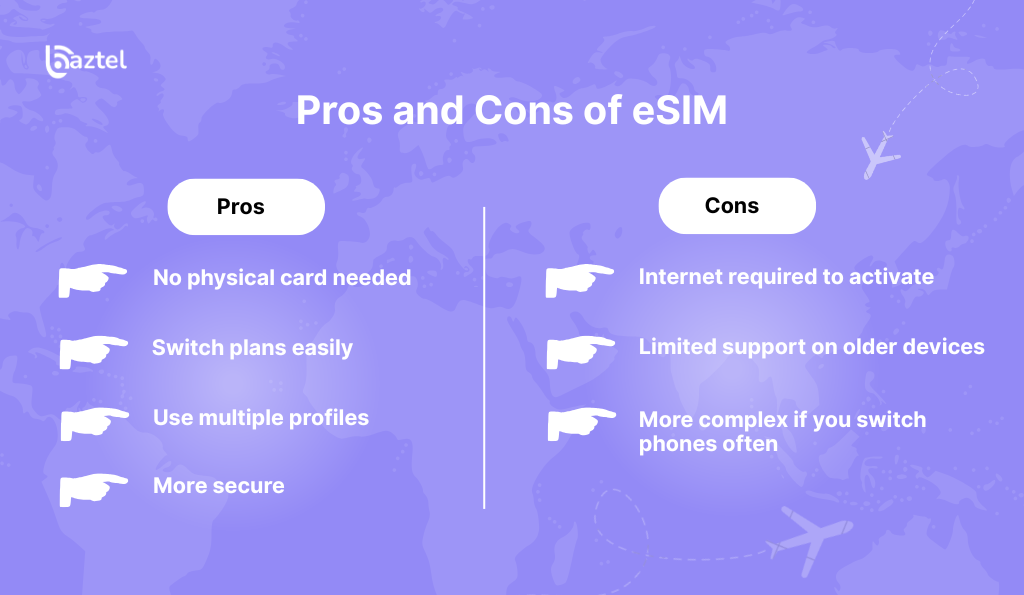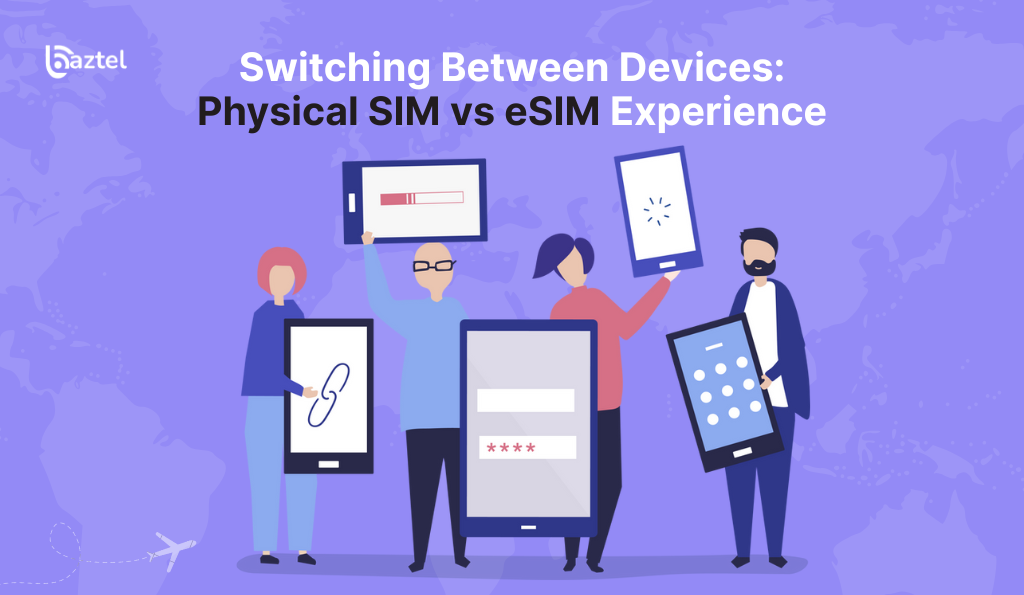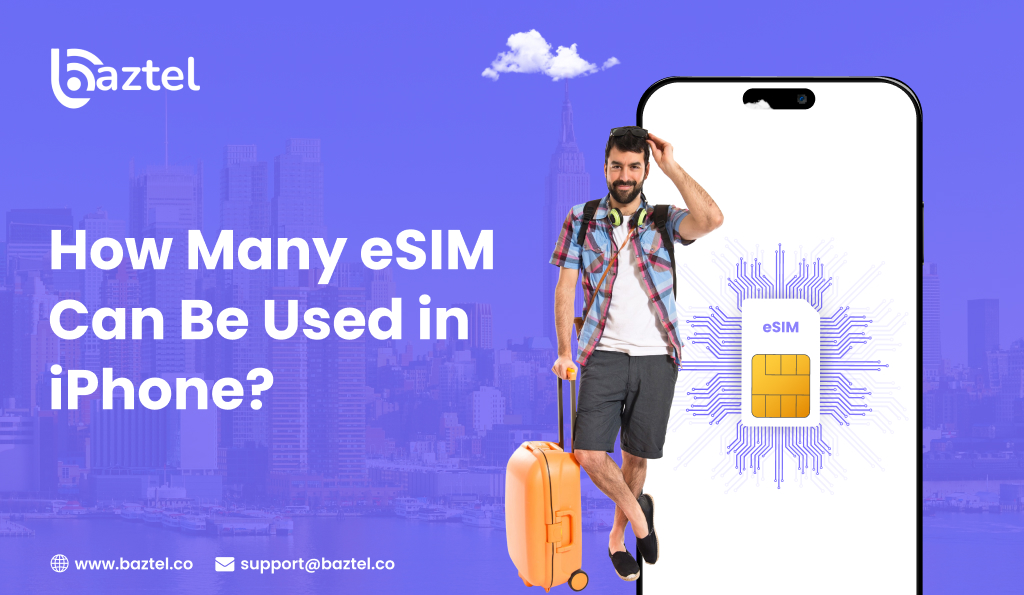When choosing a mobile plan today, you’ll hear this question a lot — physical SIM vs eSIM — which is better? Both connect your phone to a mobile network, but they work in very different ways.
A physical SIM card is the tiny chip you insert into your phone. It stores your mobile number and allows your device to access network services. An eSIM is built right into your phone — no chip, no slot. You activate it through software.
Now here’s where many users get confused — both options sound good. But the experience, flexibility, and security you get from each is different.
In this guide, we’ll break down physical SIM vs eSIM in simple terms. You’ll learn how they work, what makes them different, and which one fits your needs best.
What Is a Physical SIM Card?
A physical SIM card is a small plastic chip. It stores your mobile number and lets your phone connect to the network. Without it, your phone can’t make calls, send texts, or use mobile data.
Most phones still support physical SIM cards. You insert the card into your phone’s SIM slot. Once inserted, the phone reads the data and connects to your carrier.
Many people are comfortable using physical SIM cards because they are simple and work with almost every device. If you buy a new phone, you can take out the SIM and put it in your new one.
Later in this guide, we’ll compare physical SIM vs eSIM so you can decide which one suits you better.
How Does a Physical SIM Card Work?
A physical SIM card holds key information about your mobile service. This includes your phone number, your carrier details, and security settings.
When you insert the SIM into your phone, the device reads this data. It then connects to your carrier’s network. That’s how your phone starts working — calls, messages, mobile data — all made possible by that tiny chip.
If you switch phones, you take out your SIM and insert it into the new device. This is one reason why people still like physical SIM cards. Moving between phones is simple and quick.
Later, when we cover physical SIM vs eSIM, you’ll see that this flexibility is handled differently in an eSIM setup.
Pros and Cons of Physical SIM Cards

When deciding between a physical SIM and an eSIM, it’s helpful to know each option’s strengths. Below are the pros and cons of using a physical SIM card.
Pros
- Simple to use: Insert the SIM and you are connected. There is really nothing else you need to do.
- Easy to switch phones: If you switch phones, just take the SIM to a new device and your number goes with it.
- No internet required for setup: You do not need Wi-Fi or mobile data to activate or change a physical SIM.
Cons
- Can get lost or damaged: It’s a tiny chip. If it breaks or goes missing, your connection is gone.
- Limited to one carrier: If you want to switch carriers, you often need to get a new SIM.
- Manual swaps: Switching between multiple numbers means physically swapping SIMs each time.
This traditional method still works well for many. But as we move forward in this physical SIM vs eSIM guide, you’ll see why more users are now considering eSIM.
What Is an eSIM?
An eSIM is a new version of a SIM card — it’s embedded into your phone. There’s no physical chip to insert or remove. The “e” stands for embedded.
With an eSIM you are not switching out a chip card, but activating an eSIM by using software. Typically scan the QR code or use your carrier app to setup and the phone will download your mobile profile for your mobile carrier to connect your phone onto the network.
This technology is growing fast. Many new phones, tablets, and even smartwatches now support eSIM. It offers more flexibility — you can add or change mobile plans without touching your device.
As we explore physical SIM vs eSIM further, you’ll see that this built-in feature removes many of the hassles linked to physical SIM cards.
How Does an eSIM Work?
An eSIM works just like a physical SIM — it connects your mobile phone to the mobile carrier’s network. But the process is fully digital.
When you activate an eSIM, your carrier sends a small data file. Learn how eSIM works and why this process is faster than with physical SIM cards. Your phone downloads this profile and stores it on its built-in chip.
Once activated, your phone connects to the network — no chip, no SIM slot needed. If you want to switch plans or carriers, you simply delete the old profile and load a new one. No need to visit a store or wait for a SIM delivery.
In the physical SIM vs eSIM debate, this is where eSIM offers clear convenience — everything happens through software.
Pros and Cons of eSIM

As eSIM mobile phones increase in the quantity of supported devices, it’s important to understand where it excels and where it doesn’t. This section will assist you to weigh the pros and cons while comparing a physical SIM vs eSIM.
Pros
- No physical card needed: You can activate your connection instantly — no need to handle or wait for a SIM.
- Switch plans easily: You can change carriers or add plans through your phone’s settings. No visits to a store.
- Use multiple profiles: Many phones let you store more than one eSIM profile, making it easy to manage work and personal numbers.
- More secure: Since there’s no card to steal or lose, your connection is safer.
Cons
- Internet required to activate: You need a Wi-Fi connection to set up your eSIM.
- Limited support on older devices: Not all phones and networks fully support eSIM yet.
- More complex if you switch phones often: Moving an eSIM between devices can take more steps compared to popping out a physical SIM.
Next, we’ll cover the key part of this guide — physical SIM vs eSIM: what’s the difference?
Physical SIM vs eSIM: What’s the Difference?
On the surface, a physical SIM and an eSIM appear to do the same thing – they connect your phone to a mobile network. However, they do it in different ways and offer you different experiences.
When you compare physical SIM vs eSIM, think of it this way:
- With a physical SIM, you’re dealing with a chip you can touch.
- With an eSIM, everything happens inside the phone — no card required.
This change brings new benefits, but also new things to consider. In the next few sections, we’ll look at these key differences in more detail so you can decide which option fits your needs better.
Key Technical Differences: Physical SIM vs eSIM
| Feature | Physical SIM | eSIM |
| Form | Removable plastic chip | Embedded chip inside the device |
| Activation process | Insert card and restart phone | Scan QR code or activate through app |
| Switching between devices | Move SIM card to new device | Requires reactivation on new device |
| Support on devices | Almost all phones support it | Newer phones, some wearables support it |
| Time to activate | Instant after inserting SIM | Instant after downloading profile |
| Security | Can be lost, stolen, or damaged | Cannot be physically removed or lost |
| Multi-line support | Requires dual SIM phones | Supports multiple profiles on one phone |
| Setup requirements | No internet needed | Needs internet (Wi-Fi) to activate |
| Ideal for frequent travellers | Requires buying local SIM in each country | Add international plans easily. You can explore Europe eSIM plans, Asia eSIM plans or Middle East eSIM plans for seamless travel. |
Device Compatibility: Which Phones Support eSIM?
One of the key points in the physical SIM vs eSIM discussion is device compatibility. Not all smartphones support eSIM yet – but this is changing quickly as many newer smartphones now come with a physical SIM slot for an SIM + eSIM support. You’ll have all the flexibility to choose what is best for you.
Here is the easiest way to check:
- If the phone is a flagship or mid-range phone and released in the last 2-3 years, the chances are it supports eSIM!
- Budget phones or older models may only support physical SIMs.
Some of the most popular eSIM-supported phones are recent iPhone, Samsung Galaxy models, Google Pixel devices and many flagship Android phones.
When you are considering the change in your choice of physical SIM vs eSIM, always check your phone’s specifications. If your phone supports eSIM, you will likely see an option to add an eSIM under your mobile network settings. Not sure? Check eSIM compatible devices before making the switch.
Switching Between Devices: Physical SIM vs eSIM Experience

Switching phones is something most of us do every couple of years. Here’s where the physical SIM vs eSIM experience can feel very different.
With a physical SIM, the process is simple — take the SIM out of your old phone, pop it into the new one, and you’re done. Your number, calls, and texts move instantly.
With an eSIM, it works differently. You can’t remove a chip, since it’s built in. Instead, you need to delete the eSIM profile from the old phone and activate it again on your new device. This usually involves scanning a new QR code or using your carrier’s app.
While this sounds more technical, it’s becoming easier. But if you switch phones often, a physical SIM is still quicker to move around. That’s one of the key practical differences in physical SIM vs eSIM.
Activation Process Compared: eSIM vs Physical SIM
One of the biggest differences in the physical SIM vs eSIM debate is how you activate each one.
A physical SIM is plug-and-play. You insert the SIM into your phone, restart it, and your number becomes active. No internet needed. No apps to download.
An eSIM takes a few more steps. You usually scan a QR code provided by your carrier or follow eSIM setup steps in their app.. Your phone then downloads your mobile profile and connects to the network. This process does require an internet connection (usually Wi-Fi) for the initial setup.
Once done, both physical SIM and eSIM give you the same result — a working mobile connection. But if you want the fastest, simplest activation, physical SIM still wins.
For flexibility and future-proofing, though, many users now prefer the eSIM route.
Physical SIM vs eSIM: Which One Is More Secure?
Security is another key factor in the physical SIM vs eSIM comparison. Both options are safe, but they handle risks in different ways.
A physical SIM can be lost, stolen, or swapped without your knowledge. If someone takes your SIM and puts it in another phone, they can access your calls and texts. SIM swapping scams are one example of this risk.
An eSIM, on the other hand, is embedded in your device. There is no physical card to steal. To move your eSIM to another phone, one usually needs your account login and a security verification process. This adds an extra layer of protection.
That said, no system is 100% safe. If your phone is stolen and unlocked, both SIM types are vulnerable. Using features like phone lock codes, two-factor authentication, and carrier PINs help protect you either way.In short — in physical SIM vs eSIM advantages, eSIM offers better protection against physical theft and swapping.
Is an eSIM Better Than a Physical SIM for International Travel?
This is one of the most common questions in the physical SIM vs eSIM debate. If you travel often, which option works better?
A physical SIM has been the go-to choice for years. When visiting a new country, you buy a local SIM, insert it into your phone, and start using local rates. Simple, but it means dealing with physical cards and sometimes finding a local store.
An eSIM makes this process much easier. You can buy and activate international eSIM plans before your trip — often online. No need to hunt for a SIM card when you land. You just scan a QR code, and your phone connects to a local network instantly.
Many frequent travellers now prefer eSIM for this reason. See our full list of best eSIM plans for frequent travellers. It saves time and lets you manage multiple plans on one device. In the physical SIM vs eSIM comparison, eSIM clearly wins for travel convenience.
Which Is More Cost-Effective: Physical SIM or eSIM?

Cost is an important part of the physical SIM vs eSIM decision. Many users ask — which one saves more money?
The truth is — it depends on how you use your phone.
A physical SIM usually comes free when you sign up for a mobile plan. If you stay with one carrier and rarely change numbers, it’s a very low-cost option. But if you travel often or switch networks, buying new SIMs can add up over time.
An eSIM often gives you better deals, especially for travel. Many online eSIM providers offer short-term or prepaid plans at competitive prices — without the need to buy a new SIM card each time. Some carriers even waive activation fees for eSIM.
In the long run, if you value flexibility and travel convenience, eSIM can be more cost-effective. For basic local use, a physical SIM still works just fine.
Your choice depends on your habits — and that’s why knowing the difference in physical SIM vs eSIM cost matters.
Final Verdict: Physical SIM vs eSIM — Which One Should You Choose?
Now that you know the key differences, what’s the right choice in the physical SIM vs eSIM debate?
If you like simple, familiar setups and often switch phones — a physical SIM still works well. It’s easy to use, works on nearly all devices, and doesn’t need the internet for activation.
But if you want flexibility, travel often, or like managing plans digitally — an eSIM offers clear advantages. No handling of SIM cards, easy plan switching, and better security make it a future-ready choice.
In the end, both options work. Many newer phones let you use both — giving you the best of both worlds. When choosing between physical SIM vs eSIM, think about how you use your phone today and what might matter to you tomorrow.
Conclusion
Choosing between physical SIM vs eSIM comes down to what fits your needs. Both options let your phone connect to a mobile network — but they offer different experiences.
If you want something simple and easy to move between phones, a physical SIM is still a solid choice. It works everywhere and doesn’t rely on an internet connection for setup.
If you value flexibility, travel often, or want fewer physical hassles, you can buy eSIM online and get started in minutes. You can manage multiple plans easily and switch carriers without touching your device.
As more phones support eSIM, this option will likely become more common. But for now, both physical SIM and eSIM have their place — and knowing how they differ helps you pick the one that works best for you. To get started, check our best global eSIM plans or browse country-specific eSIM plans based on your needs.
Common Questions About Physical SIM vs eSIM
Many users still have practical doubts when choosing between physical SIM vs eSIM — our FAQ on eSIM also answers common questions.
- Can I use both a physical SIM and eSIM at the same time?
Yes — if your phone supports dual SIM. Many modern phones let you use one physical SIM and one eSIM at the same time. This is useful if you want to keep work and personal numbers on one device.
- Do I need the internet to activate an eSIM?
Yes. You need a Wi-Fi or mobile data connection to download and activate an eSIM profile. Once it’s activated, though, it works just like a regular SIM.
- What happens if I lose my phone with an eSIM?
The eSIM is tied to your phone. If you lose the device, you can’t simply remove the SIM like you can with a physical SIM. But this also means thieves can’t steal and use your SIM easily. You should contact your carrier to deactivate the eSIM remotely.
- Can I easily switch eSIMs between devices?
Switching an eSIM takes a few more steps than moving a physical SIM. You’ll usually need to request a new QR code or reactivation from your carrier. It’s not instant, but many carriers are making the process smoother over time.
Blog Author
Peter
Peter started BazTel.co to make mobile internet easier for travellers. He noticed how tough it was to find good network options while visiting new countries. That’s when he built BazTel — a place where anyone can buy eSIMs online without confusion or long steps. He believes tech should be simple and useful, not complicated. When he’s free, he likes to travel, test BazTel himself, and keep improving it based on real user problems.

 Botswana
Botswana Zambia
Zambia Congo
Congo Colombia
Colombia China mainland
China mainland Chile
Chile Chad
Chad Central African Republic
Central African Republic Canada
Canada Cameroon
Cameroon Cambodia
Cambodia Burkina Faso
Burkina Faso Bulgaria
Bulgaria Brunei Darussalam
Brunei Darussalam Brazil
Brazil Aland Islands
Aland Islands Bosnia and Herzegovina
Bosnia and Herzegovina Bolivia
Bolivia Belgium
Belgium Belarus
Belarus Bangladesh
Bangladesh Bahrain
Bahrain Azerbaijan
Azerbaijan Austria
Austria Australia
Australia Armenia
Armenia Argentina
Argentina Algeria
Algeria



